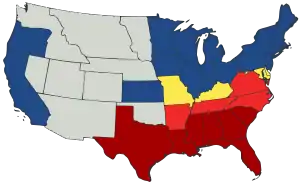Central Confederacy
The Central Confederacy was a proposed nation made up of American states in the Upland South prior to the outbreak of the American Civil War in 1861.

Background
In December 1860 and January 1861, seven states in the southern United States declared secession from the US after the 1860 election of Abraham Lincoln, out of fear that he would hurt the institution of slavery. These southern states formed the Confederate States of America.
Some prominent figures from the North, the Border States, and the Upper South suggested that the US should allow the southern states to secede peacefully.[1] In the Border and Upper South states, there were also men who wanted their states to join the Confederacy.[2] Former Congressman John Pendleton Kennedy and Governor Thomas Hicks, both of Maryland, called for a Central Confederacy composed of the states of Virginia, Kentucky, Tennessee, Missouri, North Carolina, and Maryland.
The plan
Kennedy published a pamphlet entitled The Border States on December 15, 1860, that suggested the secession and confederation of six Border States: Virginia, Kentucky, Tennessee, Missouri, North Carolina, and Maryland.[3] Hicks advocated the plan in a January 2, 1861, letter to Delaware Governor William Burton.[4] As the southern Confederacy peacefully formed, sentiment among the newspapers and people of Maryland, Delaware, New Jersey, Pennsylvania, and New York were at its highest for the formation of a Central Confederacy.[5] However, this rhetoric reversed following the Confederate attack on Fort Sumter.
References
- McPherson, James (1988). Battle Cry of Freedom. New York: Oxford University Press. pp. 276–306. ISBN 0-19-503863-0.
- "The Civil War: The Senate's Story". United States Senate. United States Senate. Retrieved 22 June 2021.
- Kennedy, John Pendleton (1861). The border states: their power and duty in the present disordered condition. Philadelphia: J. B. Lippincott & Co. Retrieved 14 September 2023.
- "The Proposed Central Confederacy" (PDF). New York Times. June 24, 1900. Retrieved 17 January 2010.
- R. A. Brock, ed. (1900). Southern Historical Society Papers. Vol. XXVIII. Richmond, Virginia: Southern Historical Society. pp. 144–147.